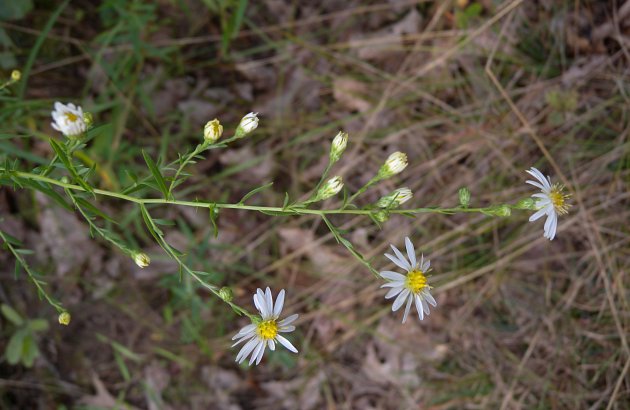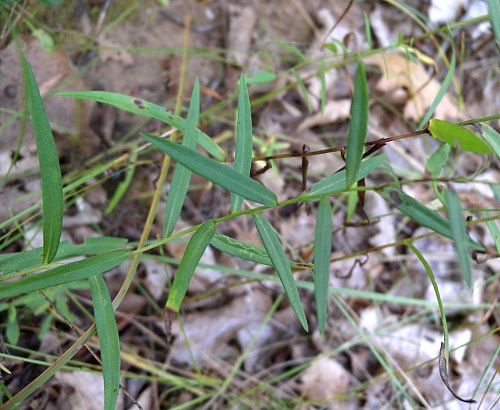Description: From late fall to spring, this perennial wildflower exists as a small basal rosette of leaves spanning up to 4½" across. As warmer weather arrives, it bolts, developing one or more flowering stems that are 1-3' long. These stems can be erect, ascending, or sprawling; they are sparingly branched, slender, light green, terete, and glabrous. Alternate leaves along the stems are about 1½–3" long and 1/8–1/4" (3-6 mm.) across; they are linear-lanceolate or narrowly elliptic, medium green, glabrous, and sessile. The leaf margins are either rolled inward and smooth or shallowly and sparingly toothed. Each alternate leaf has a single central vein that is prominent.

The central stem
(and any lateral stems) terminates in a rather airy panicle of
flowerheads about 6-9" long and a little less across. Generally, the
flowerheads are more or less erect in relation to the panicle, which
often leans sideways to some extent; the flowerheads are not secund
(always facing upward away from the ground). The ascending branches of
the panicle are slender, light green, and glabrous. Individual
flowerheads develop from terminal branches that are usually ½" or more
in length. Several small leafy bracts occur along the terminal
branches; these bracts are linear in shape and less than ¼" in length.
Larger leafy bracts can occur on non-terminal branches. Each flowerhead
is about ½" across, consisting of 15-25 white ray florets and 10-20
yellow disk florets; the disk florets later become reddish purple. At
the base of each flowerhead, there
are small appressed floral bracts in
3-5 series that surround the involucre; this involucre is 3-6 mm. long.
The floral bracts have dark green tips, otherwise they are light green;
these dark green tips are rhombic-obovate or rhombic-oblanceolate in
shape. The blooming period occurs from late summer to early fall and
lasts about 1 month. The florets are replaced by small achenes with
sessile tufts of white hair, which are distributed by the wind.
Individual achenes are bullet-shaped with 3-5 prominent ribs and they
are pale pink to straw-colored. The root system is fibrous and
rhizomatous; on an older plant, a small caudex may develop. Vegetative
offsets are sometimes formed by the rhizomes.
Cultivation:
The preference is full or partial sun, moist to dry-mesic conditions,
and sandy soil. Individual plants may lean to the side when they bloom.
Range & Habitat:
The native Rice Button Aster is an uncommon plant that is found
primarily in
sandy areas of NE Illinois; elsewhere in the state, it is rare or
absent. Illinois lies close to the northern range limit of this
species. Habitats include dry-mesic sandy savannas, interdunal swales,
moist meadows, areas along sandy paths, and abandoned fields. Rather
oddly, Rice Button Aster gravitates toward either fairly dry or poorly
drained habitats.
Faunal Associations:
The nectar and pollen of the flowerheads attract numerous insects,
including long-tongued bees, short-tongued bees, wasps, flies,
butterflies, skippers, and beetles. Among the bees, honeybees,
bumblebees, green metallic bees, dagger bees (e.g., Calliopsis), and
oligolectic Andrenid bees (e.g., Andrena asteroides) are known to visit
the flowerheads of Rice Button Aster. For many of these insect
visitors, Symphyotrichum spp. (Asters) are an
important
source of late-season nectar and pollen. Other insects feed on the
foliage, suck plant juices, bore through the stalks and roots, or gnaw
on the flowerheads and developing seeds. These insects include
long-horned beetles, leaf beetles, aphids, leafhoppers, lace bugs,
plant bugs, fly larvae (Cecidomyiidae), and caterpillars of butterflies
and moths. The Wild Turkey occasionally feeds on the leaves and
seedheads, while White-Tailed Deer and the Cottontail Rabbit browse on
the foliage.
Photographic Location:
A sandy savanna at Hooper Branch Savanna Nature Preserve in Iroquois
County, Illinois.

Comments: This is one of many white-flowered asters that can be found in Illinois. Rice Button Aster is a slender and delicate-looking plant that is rather variable across its range: different varieties have been described. It is perhaps most similar in appearance to Symphyotrichum racemosum (syn. Symphyotrichum vimineum, syn. Symphyotrichum fragile), which also has small white flowerheads. The latter species differs from Rice Button Aster by its slightly smaller flowerheads (1/3" or 8 mm. across); these flowerheads are more secund (facing upward away from the ground) and they are usually produced in greater abundance. Furthermore, the terminal branches of its flowerheads are usually shorter than those of the Rice Button Aster. An alternative scientific name of Rice Button Aster is Aster dumosus.